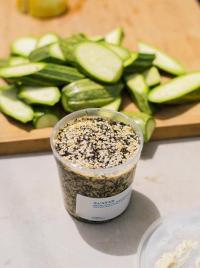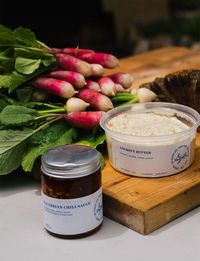The Garden Of — Santa Ynez, CA
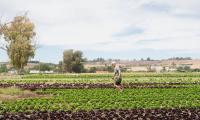
Across our restaurants we've long sourced produce from the Takikawas, and their reputation for superb quality and an adherence to consciously sustainable practices precedes them.
Interview by Sam Rogers

Tell me, how has the farm evolved over the years?
Shu: Just before our son Ky was born, the baby became our priority. Just Debby and I were farming at the time, and as Ky grew up, he became involved as well, starting with pulling up the carrots. He would always break the tops off the carrots, and laugh. We used to bunch them, but after Ky we started selling them with the tops off. There are so many great memories of having the baby on the farm.
Debby: Ky went to every single farmers market, from the time he was 6 months old. When he got older eventually he started unloading the broccoli - he was busy in the market with us from the very beginning and it's in his blood. That was our big pleasure in developing our farm and our farming practices: to be 100% safe in every way for Ky to be involved… dirt in his mouth or rolling around in the mud. Whatever he was doing, he was safe at the farm.
Shu: As Ky grew up, the farm grew….We expanded our markets to Tuesday Santa Barbra, and then Wednesday Solvang, Sat Santa Barbra and later Sunday Hollywood. We then added on Mar Vista on Sunday. Lastly we added on Santa Monica Wednesday. With all the markets growing, we had to thin out our locations and start to really concentrate on the ones we were in. Eventually, by now, we cut our markets to just the two a week.

I imagine your truck gets maxed-out too?
Debby: Yes but honestly it was just too much demand on the fields. It was starting to intersect with the threat of the decrease of water. We haven't lost water yet, but it has been a wake-up call for us. Shu has been very earnest in changing his farming methods to adapt to what is coming. It is coming, and climate change is real. California is in a drought, which is very obvious if you’re willing to look at it, which not everyone is, but we have to be. One of the ways to conserve water is to cover your land in plastic. It works but we are just not going to do that. So we needed to figure something else out.
With the world changing, what are you going to do?
Shu: Three years ago I got a nice no till grain drill, so I can plant any seed directly into the dirt. It doesn't matter how hard the land is, I can plant a cover crop, even if there was another crop growing. It is that good. We were abusing the soil to keep up with demand with our three markets. We needed time to plant more cover crop, more time between harvests. With this I was able to plant cover crop into very recently harvested soil which still had water retention. It was easy to germinate the cover crop in these conditions, so I was able to save water. Cover crop is precious. After it decomposes it makes air passages within the soil and also a water pathway. It builds a beautiful soil structure.
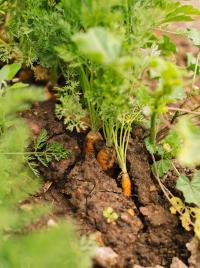
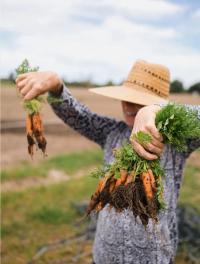
How did you begin this process?
Shu: We pulled out all the grapes we had once planted in the three acres in front of the house and I have been conducting no till practice there. I have been planting and growing cover crop in the fields back to back, one planting after another. I've been doing this for about a year and half, nothing but cover crop all the time, and never discing under. Just layer after layer from the top– covering the earth instead of plastic, like a forest. Everything decomposes from the top, year after year, season after season, it decomposes naturally, the roots and the other creatures have never been disturbed by cultivating the soil. Eventually I would like to put beans, winter squash, and watermelons in that space. I can’t do carrots because that would disturb the root structure. You wouldn't believe how thick the materials on the ground are. So that's a project that we are working on, along with all our normal production.
Cover crop is conserving the water by basically pulling the water up from underground, retaining it, decomposing and putting it with nutrients back into the soil, so also building the soil at the same time. We are building it up from the surface down, as we aren't plowing anything under. There is way less evaporation this way. There is a certain amount of respiration from the plant while it is growing and we do a small amount of irrigation to get the cover crop to grow. We don't have summer rains like they do in the midwest or back east, so we need to irrigate a little, but then we knock that back down again and it provides another layer. It's really interesting to look down through the layers and see what's going on and all the different organisms and animals making their home here. Right now we have so many mice out in the field which has led to a beautiful congregation of egrets that have shown up. The ecosystem, if you create it or give nature the space…. they will come.
However, what we are doing is somewhat unnatural to this area. Normally, with no-till in the midwest and in places where they have a snowy winter, they plant the cover crop, it snows, the cover crop grows through the snow in the spring, and then they knock it down. The top soil there is 8 feet deep or something, so this stuff grows really fast and grows really tall. Our top soil is currently 10 inches. It’s going to take us a few years to even build up the amount of organic material that a normal no till farm on the midwest would have after one planting. We have to do this over and over and over to get a head start because it is not what the climate here does naturally. Santa Ynez is located in a sub-desert here, so we are doing something that is not natural to this environment. What is natural to this environment is to just grow grass in the winter and a few scattered oak trees. We are augmenting that in a big way, creating an unusual ecosystem, but an ecosystem that (we believe) once we get it up and running can be maintained fairly simply and we can plant into it. We will never till it, the moment we till it, we are back to square one and we need to start all over again.
Debby: We are thinking of all kinds of things that we can do. Shu is developing his transplanters so they can slide over the surface or drill down into the cover crop that is knocked over, but is still flat grass laying flat on the ground. You can't use the normal transplanter because it has skids and it picks up any debris. So, bit by bit, Shu is developing these transplanters that will work in this manner.
If we grow seedlings with tall stems, like broccolini, kale, and all the brassicas, then we can start planting some of these regular transplant crops. The one thing we are not sure about is how we would grow into the cover crop anything we grow by seed - the spinach, the arugula, the carrots– that's still going to have to go into the bare ground, traditionally, the way we have always farmed them.
After I finish harvesting my crop, like lettuces, I till the field, discing everything under, and then planting cover crop. I used to leave it as bare ground for a long time, then I would have to put the overnight sprinklers in order for me to be able to work the field, because the soil was so compacted. Now, with the immediate cover crop, I just irrigate the cover crop from time to time. Because of the remaining moisture I am able to plant cover crop seed directly, and it necessitates using far less water.
When I go to make a bed, I don't need to water before, as the soil always has some moisture. I used to disc really deep into the ground, but now I am able to disc much more easily, because my soil isn't so compacted. I'm about to do a very shallow discing, just enough to break the compaction and get the soil to shake a little. I am able to pass the tractor two times less than I used to when I would make a bed for the next crop.

What is the reason that your product has such longevity post-harvest? We have never seen anything like it….
Shu: If we cannot meet our standards on a product, then we don't offer it. If I can't give it the care it deserves, I can't sell something with inferior quality. If I can’t give the customers the quality I would like to have, then I'd rather not grow it.
Debby: We do a field pack when the dew is still on the leaves early in the morning. We don’t harvest in hot dry conditions. Since the lettuce is moist and cold from the early morning harvest we can just put it into the cooler. If for some reason it looks to dry we run a bit of drinking water over the top of the packed box. We never use a hydro cooler with ice water because the lettuce is not hot when we harvest.
Mainly, we work really really hard at it.
At home:

Bring the garden home — pair The Garden Of's abundant varieties of fall greens and roasted vegetables with our housemade Gjusta spreads, dips, bakery breads, and more.
